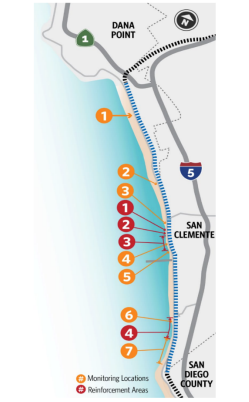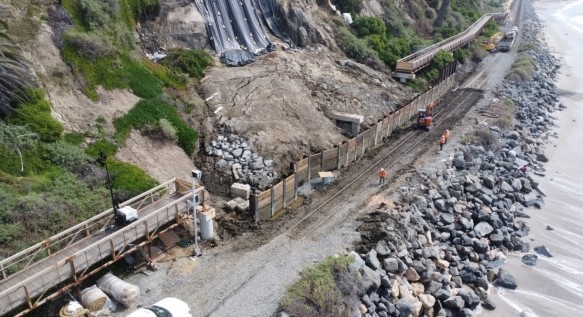While emergency work in San Clemente has been top priority, OCTA continues to work with local, state and federal partners to study and secure funding for lasting solutions
ORANGE – While the Orange County Transportation Authority and Metrolink team continues emergency work to protect the rail line in San Clemente at Mariposa Point, OCTA is pushing ahead on a study to find lasting solutions to prevent additional emergencies by addressing other areas in need of reinforcement.
On Monday, the OCTA Board received an update on the Coastal Rail Resiliency Study and an initial assessment that identified sites along the coastal rail line recommended for monitoring and reinforcement to ensure that rail traffic can continue moving without additional interruptions.
“We understand this rail line is vital for the safe movement of people and goods in Orange County and the region,” said OCTA Chair Tam T. Nguyen. “So even as we complete the emergency work, OCTA is moving forward on many fronts, along with all our partners and stakeholders, to make sure we are protecting the coastal rail line for many years to come.”
 The OCTA-led Coastal Rail Resiliency Study aims to evaluate and implement strategies to fortify the railway in the vulnerable 7-mile stretch between Dana Point and the San Diego County Line and to keep rail traffic moving through the area for the next 30 years, while longer-term solutions are explored.
The OCTA-led Coastal Rail Resiliency Study aims to evaluate and implement strategies to fortify the railway in the vulnerable 7-mile stretch between Dana Point and the San Diego County Line and to keep rail traffic moving through the area for the next 30 years, while longer-term solutions are explored.
The initial assessment presented to the Board on Monday identified seven areas along that stretch in need of reinforcement and monitoring, to prevent additional soil and debris from privately owned hillsides from falling into the rail right of way. The potential solutions are meant to protect the track from threats on the coastal and inland side caused by erosion and storm surges, among other risks.
Potential solutions for near-term reinforcement include installing monitors to analyze soil or track movement, building additional catchment walls, and engineering placement of large protective boulders (known as riprap) where appropriate.
Bringing in additional sand on the coastal side, as mentioned by numerous community groups and members of the public, is also being studied as part of the longer-term solution.
The immediate goal is to address the areas identified in need of reinforcement as soon as possible before the next storm season arrives. OCTA will continue to work with local, state and federal partners and explore all funding options.
At the same time, OCTA is working on the Coastal Rail Resiliency Study, meeting with groups of stakeholders in individual listening sessions to discuss the study and get input all along the way.
Two listening sessions with the public are being planned:
- April 11, a virtual public meeting via Zoom will be held to get public input.
- May 30, an in-person public meeting will be held in San Clemente. (Details about the time and location of that meeting are still being finalized.)
- To register to attend either meeting and receive updates, please visit: www.octa.net/CRRS.
While the areas in need of immediate reinforcement are being addressed, the Coastal Rail Resiliency Study continues. The initial concepts developed with community input are scheduled to be presented later this year, then refined, before a draft plan to address protecting the rail line in place for the next 10 to 30 years goes to the OCTA Board in 2025.
Because California continues to grapple with the increasing prevalence of storm-related damage to its transportation infrastructure, OCTA recognizes the importance of adaptive strategies to maintain safe and efficient rail services.
OCTA will also work with all partners and stakeholders to explore long-term solutions for protecting rail movement for generations to come – solutions that could eventually include moving the rail line inland. As part of those long-term efforts, OCTA is advocating for state-led capital project effort to address concerns along the 351-mile LOSSAN corridor to safeguard the future of rail transportation across the region.
Update on Emergency Work
The OCTA and Metrolink team are continuing work on a nearly 200-foot-long catchment wall at Mariposa Point (Milepost 204.2) in San Clemente to protect the track, following a Jan. 23 landslide on a privately owned slope above the rail line.
The 33 steel beams that form the foundation of the wall were finished last week, and the team on Monday finished installing the wooden panels that will make up the wall to prevent additional soil and debris from falling into the rail right of way.

On March 6, Amtrak Pacific Surfliner resumed limited passenger service through the area during morning and evening hours, so that the wall construction could continue throughout daytime hours.
With the catchment wall in place, grading, drainage and additional track work will continue throughout this week. Once the construction work is finished, OCTA, Metrolink and the LOSSAN Rail Corridor Agency will work together to safely restore full passenger service as soon as possible. That schedule is still being determined.
Passengers are asked to check for the latest service updates at www.metrolinktrains.com and www.pacificsurfliner.com/alerts.
For more information and updates on the current rail work visit www.octa.net/railupdates.